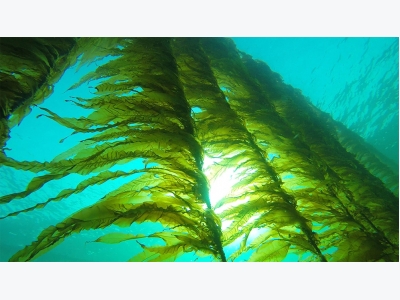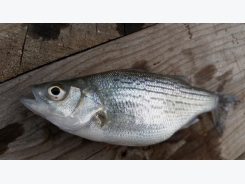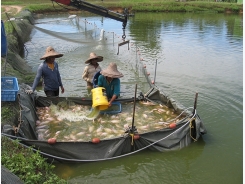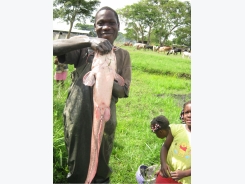Can aquaculture flourish in a more symbiotic sea?

EU initiative urges collaboration with wind and wave energies and offshore seafood production
Seaweed farms are looking to move further offshore, into areas not previously considered, and collaborate with wind and wave energy operations. Some see an opportunity to become more efficient and share costs. Image courtesy of Seaweed Energy Solutions (SES).
A new EU project led by University College Cork (UCC) in Ireland has been looking at smarter and more sustainable ways of sharing sea space. Project leader Dr. Gordon Dalton, a research fellow at UCC, believes partnerships with renewable energy providers – wind and waves – could allow aquaculture to play an increasingly larger role in global protein production.
Funded under the European Commission’s Horizon 2020 Blue Growth program, the 18-month Maribe (Marine Investment in the Blue Economy) Project has uncovered some promising ideas for promoting growth and jobs within the blue economy.
Blue Growth, which promotes best use of Europe’s ocean areas and coastlines, has identified five key areas for sustainable growth, one of which is aquaculture.
“Aquaculture needs to move offshore, to access more nutrient-rich and less polluted waters, which will help with public acceptance of products farmed in the sea,” said Dalton. “We believe that multi-use platforms, sharing of a single space and consequent cost sharing, offer the greatest potential for this to happen.”
Europe’s aquaculture production is currently worth €1.6 billion at first-sale value and accounts for 90,464 jobs, while the overall blue economy represents around 5.4 million jobs and generates a gross added value of almost €500 billion per year.

The Maribe Project is exploring cooperation opportunities for companies that combine different Blue Growth and Blue Economy sectors. Graphic courtesy of the European Union’s Horizon 2020 Project.
Yet synergies among marine industries are currently limited.
The Maribe project, which worked with 11 partners from Ireland, United Kingdom, Belgium, Spain, Italy, Malta and the Netherlands, acknowledges the considerable potential for further blue growth and for collaboration amongst different industry partners.
Making the most of multi-use spaces
Attention was paid to the potential for sharing aquaculture with new and emerging industries such as marine renewable energy, marine biotechnology and seabed mining. The study also looked at previous projects that focused on multi-use of space or platforms such as Mermaid and Tropos, and rated the potential for various combinations from technical, environmental, socio-economic, financial and commercial perspectives.
“This was a ground-breaking project that helped to identify synergies between different users of the marine space, and enabled us to work up case studies on nine potential combinations of businesses. These included aquaculture with innovative wind and wave power solutions,” said Dalton.
The nine multi-purpose projects were assisted to prepare for a Dragon’s Den-type presentation, which included developing a viable business plan and financial projections.
Aquaculture needs to move offshore, to access more nutrient-rich and less polluted waters, which will help with public acceptance of products farmed in the sea.
In June 2016, each project was pitched to an international panel including representatives from Ernst & Young, DNB Norway, Scottish Investment Bank, ORE Catapult, International Energy agency, World Ocean Council and trade associations. The aim was to provide valuable feedback and impartial advice to assist individual projects to move towards a commercial stage and to secure funding.
One interesting project combines offshore wind turbines mounted on floating platforms, sharing space with fish cages. Proposed by Grupo Cobra, which has experience working with fixed wind farms, and Besmar, an offshore aquaculture consulting company, the aim is to undertake trials off the southeast coast of Gran Canaria, which lies off the west coast of Africa.
Advantages of such a collaboration include more efficient use of licenced space, which is generally in limited supply, and the ability of floating wind farm structures to project fish cages from damage by currents and waves. There are also financial benefits from sharing expensive security and monitoring systems.
Wave energy converters
Another project plans to use a wave energy converter (WEC) in combination with a seaweed farm. Wave Dragon, a Danish/UK based company hopes to deploy an array of wave energy converters off the Welsh coast.
Their plan is a good fit for Norwegian company Seaweed Energy Solutions (SES), which is looking to move seaweed farms further offshore, having completed a successful trial growing seaweed in inshore waters in Norway. Its farm in Frøya is one of the largest seaweed cultivation farms in Europe.
“It’s really interesting to explore new collaborations between marine actors in the use of ocean space,” said Frank Neumann, a civil and wave engineering expert on the SES staff.
“By doing so we can become more efficient, share technological learning, share installation and maintenance costs, and most importantly, take our seaweed farms into areas we couldn’t previously consider. We already work with Norwegian fish farming companies and are looking forward to collaborating with a wave energy company to make the vision a reality.”
The seaweed farm will benefit from calmer waters when situated behind the Wave Dragon array, and during times of rough weather, the farm structures can be lowered into deeper water using electricity generated by the WEC. Electricity will also be exported to the national grid.
Another wave energy/aquaculture project is being developed by Albatern and AquaBioTech Group. Albatern’s radical new wave energy device WaveNET, captures energy from ocean waves and converts it into sustainable low-carbon electricity.
It’s really interesting to explore new collaborations between marine actors in the use of ocean space.
It is planned to install WaveNET close to fish farms in Ireland, Scotland, Wales and Malta, up to 6 kilometers offshore. The aim is to provide electricity direct to the fish farms, whose feeding systems are energy intensive, thereby reducing running costs and ensuring a supply of sustainable energy.
Onshore fish farm installations situated in areas of high wave energy could also benefit from cheaper energy costs by siting a WaveNET installation in the vicinity.
“Maribe 1 was an exciting project and we have already applied for funding to help us undertake Maribe 2. This is a project that will enable us to identify sources of public/ private partnership funding for large-scale deployment of multi-purpose platforms and multiple use of space, involving multiple partners. We should hear early in 2017 if we have been successful with the bid,” said Dalton.
Work has also just started on a bid for Maribe 3, a project that will demonstrate the exact nature of any mutual benefits from sharing marine space.
“Maribe 3 will combine the projects of several different stakeholders who participated in the first project, in a full-scale pilot,” Dalton said. “The aim is to deploy a multi-use shared platform that will provide cost savings and synergies for finfish, mussel and macro-algae farms. It will be powered by wave and wind energy and be deployed in Malta.”
Not one to stand still, Dalton is also working up projects with other stakeholders from Maribe 1, and seeking out new sources of research funding to help investigate them further.
Related news
Tools

Phối trộn thức ăn chăn nuôi

Pha dung dịch thủy canh

Định mức cho tôm ăn

Phối trộn phân bón NPK

Xác định tỷ lệ tôm sống

Chuyển đổi đơn vị phân bón

Xác định công suất sục khí

Chuyển đổi đơn vị tôm

Tính diện tích nhà kính

Tính thể tích ao




 Innovation projects: ‘groundbreaking’ for Norwegian aquaculture
Innovation projects: ‘groundbreaking’ for Norwegian aquaculture  Investing in Africa’s aquaculture future, part 2
Investing in Africa’s aquaculture future, part 2